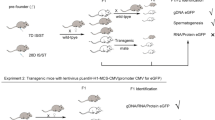Abstract
Purpose
The study aimed to generate a mouse line with green fluorescent protein (GFP) specifically expressed in male germ cells to assess testicular toxicity.
Procedures
The mouse line with GFP specifically expressed in male germ cells was generated by mating a germ cell-specific transgenic Cre male mouse with a double-fluorescent reporter female mouse using Cre/loxP. The mouse line was administered ethylene glycol monomethyl ether (EGME) by oral gavage. Then, the green fluorescence intensity in the testes was used as an indicator to examine the potential for testicular toxicity testing by molecular biology, histopathology, and in vivo imaging techniques.
Results
Specific testicular GFP expression was observed in mice. GFP was mainly expressed in the germ cell lineage and concentrated in secondary spermatocytes/spermatocytes and spermatozoa. After administration of EGME, at the organ level, the green fluorescent intensity of the testes was decreased by 11 days and had disappeared by 34 days. Frozen testicular sections stained with DAPI showed significantly decreased green fluorescence in secondary spermatocytes and sperm cells. These observations were consistent with the testis weight and results of testicular histopathology.
Conclusions
With the application of in vivo imaging becoming popular, this mouse line with GFP specifically expressed in the male germ cells may have some advantages for the study of reproductive toxicity.








Similar content being viewed by others
References
Sternberg N, Hamilton D (1981) Bacteriophage-P1 site-specific recombination. 1. Recombination between Loxp sites. J Mol Biol 150:467–486
Nagy A (2000) Cre recombinase: the universal reagent for genome tailoring. Genesis 26:99–109
Antonson P, Humire P, Gustafsson JA (2016) Estrogen receptor-alpha knockout mice. Methods Mol Biol 1366:425–30
Zhang W, Freichel M, van der Hoeven F et al (2016) Novel endothelial cell-specific AQP1 knockout mice confirm the crucial role of endothelial AQP1 in ultrafiltration during peritoneal dialysis. PLoS One 11, e0145513
Roussell DL, Bennett KL (1993) Glh-1, a germ-line putative RNA helicase from Caenorhabditis, has 4 zinc fingers. P NATL ACAD SCI USA 90:9300–9304
Olsen LC, Aasland R, Fjose A (1997) A vasa-like gene in zebrafish identifies putative primordial germ cells. Mech Dev 66:95–105
Castrillon DH, Quade BJ, Wang TY et al (2000) The human VASA gene is specifically expressed in the germ cell lineage. Proc Natl Acad Sci USA 97:9585–9590
Fujiwara Y, Komiya T, Kawabata H et al (1994) Isolation of a dead-family protein gene that encodes a murine homolog of Drosophila-Vasa and its specific expression in germ-cell lineage. Proc Natl Acad Sci USA 91:12258–12262
Sano H, Nakamura A, Kobayashi S (2002) Identification of a transcriptional regulatory region for germline-specific expression of vasa gene in Drosophila melanogaster. Mech Dev 112:129–39
Yoshizaki G, Takeuchi Y, Sakatani S et al (2000) Germ cell-specific expression of green fluorescent protein in transgenic rainbow trout under control of the rainbow trout vasa-like gene promoter. Int J Dev Biol 44:323–6
Krovel AV, Olsen LC (2002) Expression of a vas::EGFP transgene in primordial germ cells of the zebrafish. Mech Develop 116:141–150
Gallardo T, Shirley L, John GB et al (2007) Generation of a germ cell-specific mouse transgenic Cre line, Vasa-Cre. Genesis 45:413–7
Muzumdar MD, Tasic B, Miyamichi K et al (2007) A global double-fluorescent Cre reporter mouse. Genesis 45:593–605
Foster PM, Creasy DM, Foster JR et al (1984) Testicular toxicity produced by ethylene glycol monomethyl and monoethyl ethers in the rat. Environ Health Perspect 57:207–17
Bagchi G, Waxman DJ (2008) Toxicity of ethylene glycol monomethyl ether: impact on testicular gene expression. Int J Androl 31:269–74
Toppari J, Larsen JC, Christiansen P et al (1996) Male reproductive health and environmental xenoestrogens. Environ Health Perspect 104(Suppl 4):741–803
Levi M, Tzabari M, Savion N et al (2015) Dexrazoxane exacerbates doxorubicin-induced testicular toxicity. Reproduction 150:357–366
Martino-Andrade AJ, Chahoud I (2010) Reproductive toxicity of phthalate esters. Mol Nutr Food Res 54:148–57
Shimomura O, Johnson FH, Saiga Y (1962) Extraction, purification and properties of aequorin, a bioluminescent protein from the luminous hydromedusan, Aequorea. J Cell Comp Physiol 59:223–39
Betzig E, Patterson GH, Sougrat R et al (2006) Imaging intracellular fluorescent proteins at nanometer resolution. Science 313:1642–1645
Yang M, Baranov E, Jiang P et al (2000) Whole-body optical imaging of green fluorescent protein-expressing tumors and metastases. Proc Natl Acad Sci U S A 97:1206–11
Shcherbo D, Merzlyak EM, Chepurnykh TV et al (2007) Bright far-red fluorescent protein for whole-body imaging. Nat Methods 4:741–6
Yang M, Luiken G, Baranov E et al (2005) Facile whole-body imaging of internal fluorescent tumors in mice with an LED flashlight. Biotechniques 39:170-+
Hoffman RM, Yang M (2006) Whole-body imaging with fluorescent proteins. Nat Protoc 1:1429–1438
Hoffman RM (2015) Application of GFP imaging in cancer. Lab Invest 95:432–452
Hoffman RM (2005) The multiple uses of fluorescent proteins to visualize cancer in vivo. Nat Rev Cancer 5:796–806
Hoffman RM, Yang M (2006) Color-coded fluorescence imaging of tumor-host interactions. Nat Protoc 1:928–935
Hoffman RM, Yang M (2006) Subcellular imaging in the live mouse. Nat Protoc 1:775–782
Yang M, Reynoso J, Jiang P et al (2004) Transgenic nude mouse with ubiquitous green fluorescent protein expression as a host for human tumors. Cancer Res 64:8651–8656
Chapin RE, Lamb JC (1984) Effects of ethylene-glycol monomethyl ether on various parameters of testicular function in the F344 rat. Environ Health Perspect 57:219–224
Chapin RE, Dutton SL, Ross MD et al (1984) The effects of ethylene glycol monomethyl ether on testicular histology in F344 rats. J Androl 5:369–80
Acknowledgments
We acknowledge the staff who operated the reflecting fluorescence imaging system at the College of Engineering of Peking University for their excellent technical assistance in small animal imaging. This work was supported by the Chinese National Science Equipment Development Program (No. 2011YQ030114).
Author information
Authors and Affiliations
Corresponding authors
Ethics declarations
Conflict of Interest
The authors declare that they have no conflict of interest.
Rights and permissions
About this article
Cite this article
Wang, Z., Li, J., Cao, D. et al. Generation and Application of Male Mice with Specific Expression of Green Fluorescent Protein in Germ Cells. Mol Imaging Biol 18, 659–666 (2016). https://doi.org/10.1007/s11307-016-0947-8
Published:
Issue Date:
DOI: https://doi.org/10.1007/s11307-016-0947-8




